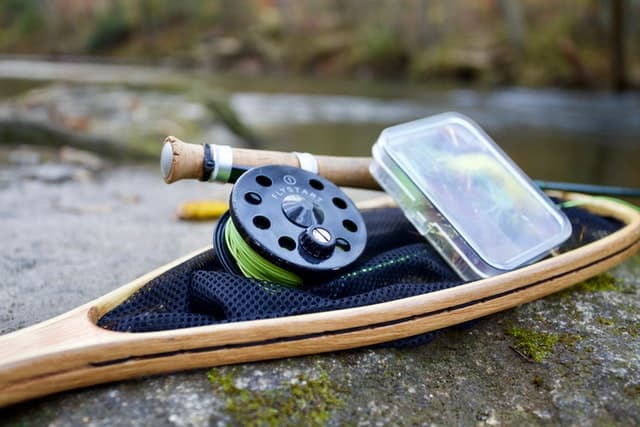The Bewl Water Trout fishing season started in March 22’, with many who enjoy the sport excited to get started. Now that the cold weather has cleared, trout, as well as other fish species, will start becoming more active as the warm water and the aquatic insects that hatch during spring ensure the trout have plenty of food to grow and temperate water to bask in. If you are a pure newcomer to fishing as a sport, then booking a tuition session at Bewl Water is a great way to learn, as you can pick up some tricks for a good catch from an experienced instructor.
Spring is a wonderful season to be out enjoying the natural world, with wildflowers in full bloom and many migratory birds headed back to the UK that you can spot if you keep your eyes peeled. Fishing in spring is the start of the season, and as such if you start fishing early in the season it can be harder to bring in a large catch as the chill left over from winter can make the fish lethargic. As the water warms the fish will be more active and easier to catch.
Equipment
One of the best tips for new anglers is to make sure you keep your fishing equipment in good condition, clean and check it before storing it at home and making sure to look it over before heading out. After spending the winder in storage, some equipment may become damaged from lack of use, so it is important to consider what might need replacing and what is good to be used for another year.
Here is some of the kit that is essential for a good catch when trout fishing:
- Lures – Whether you decide to use live bait or flies having the right lure for the trout is essential to ensuring you are able to bring in some good sized fish. Most flies are modelled after aquatic insects or flies that are prey for the trout during the spring season. The trout’s instinct will be to catch the fly to feed and you will be able to haul in a fish. Whether you buy your lures in a tackle shop or make your own, the flies you use can have a big impact on your success.
- Fishing Rod – Fishing for trout requires a rod and reel; the rods that fit trout fishing are generally between six and eight feet and are a lighter weight. Trout are a fairly light fish, so you shouldn’t need to go for a heavier duty rod. If you are finding it difficult to select a rod, the staff at the Bewl Water tackle shop will be able to help you choose.
- Line – The line you use should be specific to the type of fishing you want to do – a lighter line specifically for fly fishing if you want to fly fish for trout, and a heavier more general line for a fishing trip with weighted bait. If you are relatively inexperienced when it comes to trout fishing, don’t be afraid to ask other anglers for advice when it comes to finding equipment to fit your experience, as they may have favoured lines that will work well for you.
- Waders and Staffs – Wader and staffs are essential for fly fishing if you want to wade into the water, as they will protect you from the damp and cold. While spring is a warm season it can still get cold so it is important to have all the layers you need. If you are heading out in warm weather make sure that you bring some layers that you can put on if the weather takes a turn for the worse, so that you can stay warm.
- Landing Net – Once you have pulled in your catch, holding in a net is by far the best way to seal the deal and prevent last second escapes by the fish breaking away. A net is by far the easiest way to securely hold the fish, as while they are still alive trout will often thrash around trying to escape, making them quite difficult to keep a hold of.
Fly Fishing
Most people who fish for trout regularly fly fish for them as a matter of course. Trout are predators, whose main source of food comes from flies and aquatic insects. When you are fly fishing it is important to consider the trout and ensure that your presentation of the fly looks as natural as possible. Fish are driven by instinct, and will react in certain ways when presented with certain stimuli. In order to ensure you catch a good size trout it is crucial to ensure that your fly takes the trout’s attention. When fly fishing there are two different types of fly, the dry fly and the wet fly. Here are the pros and cons of using a dry or wet fly to fish for trout.
Dry Fly
A dry fly is generally considered the most traditional method of fishing as it endeavours to present a fly on top of the water that looks deceivingly like the trout’s natural food source so they will come up to the surface to take it. Most dry flies are made from horsehair or feathers to stay light on top of the water. As you can see the progress of the fly on the water it can be very satisfying to fish this way. While you may not be able to see where the trout are in the water, when fishing using this method it is important to target areas where the trout might want to congregate.
Wet Fly
Wet flies are created to look like aquatic insects that trout prey on seasonally, and many flies will be shaped to look like a specific insect at a select stage in its life cycle. These can be very useful when fishing on stiller waters, as they can be reused. If the trout aren’t taking one of the lures, then try a different one until you find a fly that works well in the environment.
If you are coming to fish for trout at Bewl Water this spring remember to pre-book fishing tickets and boats so that when you arrive you are not disappointed. If you are interested in fishing at Bewl Water this season, please contact us here.

